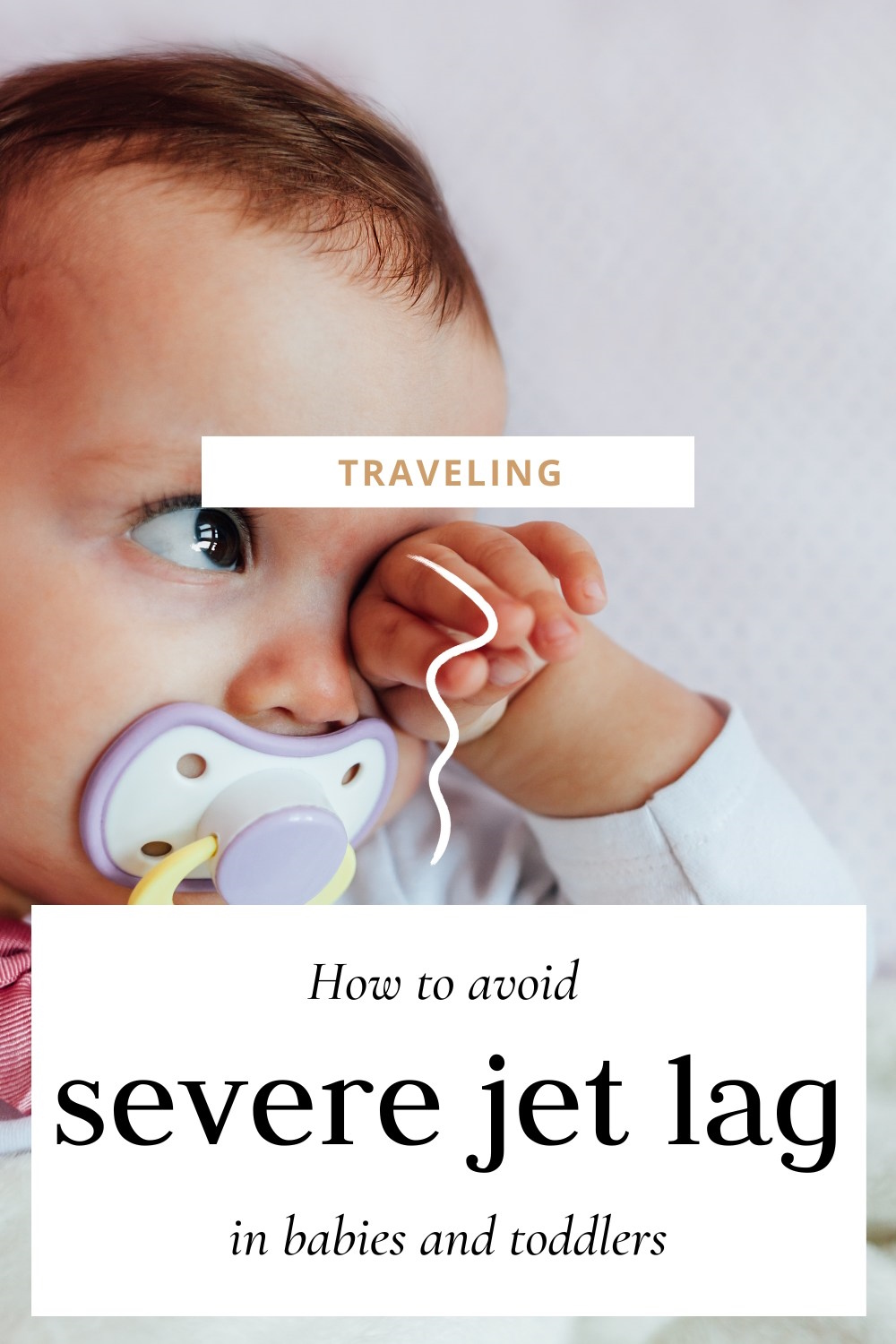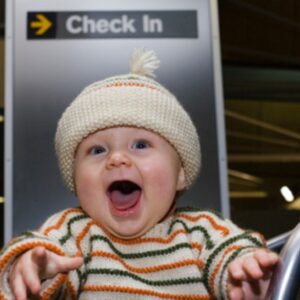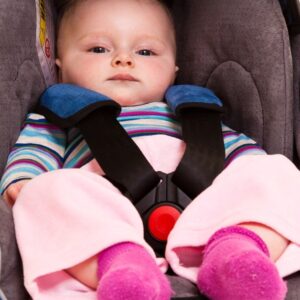Traveling with babies and young children can be super rewarding but also super exhausting. In addition to the actual planning, traveling, adapting to new foods, sleep environments, and so on, traveling over time zones means jet lag. For those of us who have struggled to get our child to adapt to daylight savings time, adapting to even more hours may not seem very tempting.
Don’t give up your traveling plans just yet, though! There are ways to both prevent and mitigate severe jet lag in babies and toddlers and in addition, young children appear to adapt more easily than adults do.

Jet lag in babies and toddlers does occur but can be prevented and mitigated with smart planning and actions upon arrival. Here’s what to do!
Preventing and Mitigating Jet Lag in Babies and Toddlers
In this article:
What Is Jet Lag?
Jet lag is a type of sleep disorder. The body’s internal sleep “clock” is out of sync with the local time of the travel destination. The daylight and darkness hours are different from what the body is accustomed to, causing a person to feel awake or sleepy at the wrong times.
Jet lag symptoms are more likely when traveling from a Western to an Eastern timezone or when the time difference is more than three hours. It can cause a baby who normally sleeps through the night to wake frequently. Toddlers may become cranky or have more tantrums until they have adjusted to the new time zone.
The Circadian Rhythm
Our sleep cycles are dependent on a normal functioning “body clock” known as the circadian rhythm. This is a 24-hour cycle that is controlled by the suprachiasmatic nucleus in the hypothalamus area of the brain. It responds when our eyes sense light or darkness and sends the appropriate signals to organs throughout the body. Different organs function more during the daytime than while sleeping.
In order for the circadian rhythm to function properly, the suprachiasmatic nucleus must regulate body temperature and the release of melatonin and cortisol. These three components allow sleep to occur at the appropriate time.
Melatonin
This pineal gland hormone helps us to fall asleep. It is suppressed by sunlight, bright indoor lights, and blue light emitted from screened devices.
Cortisol
This adrenal gland hormone helps the body manage physical and mental stress. There are lower amounts of cortisol in the bloodstream at night time. Levels increase just prior to waking and peak during the mid-morning hours.
Body Temperature
Normally, body temperature is lower during the evening hours, which helps with sleep onset.
Infant And Toddler Circadian Rhythms Are Different
At birth, a baby’s circadian rhythm has not yet developed. During fetal life, the sleep cycle is regulated by maternal melatonin and cortisol that are sent via the placenta. Newborns who are breastfed receive components that help with their sleep cycles. Daytime breastmilk is higher in cortisol and tyrosine, which keep babies awake. Evening breastmilk has more melatonin and tryptophan to promote sleep.
Early signs of a developing circadian rhythm appear between ages six to nine months, helping infants to sleep six hours or more at night.
However, the suprachiasmatic nucleus is not fully functional until age two to three years old. As a result, over 45 percent of infants have night-time fussiness, waking, or difficulty falling asleep even in their home environment. Adding travel to this scenario can make it even more difficult for babies to sleep.
Symptoms of Jet Lag
Crossing timezones may cause daytime sleepiness, overall crankiness, or few symptoms at all. Younger infants sleep at more frequent intervals and take daytime naps. If these infants continue this routine while traveling, the effects on their sleep cycle may be minimal. Older infants and toddlers who typically remain awake most of the day, however, can experience jet lag.
Possible symptoms include:
- Fussiness without signs of illness, hunger, or other discomforts
- Drowsiness during daytime hours
- Awake at times when normally asleep
- Constipation
These symptoms occur because the suprachiasmatic nucleus sends signals to the body’s organs at times that don’t fit the new time zone. For example, cortisol may be released from the adrenal glands at night instead of during the early morning hours.
What Can Be Done to Minimize Jet Lag?
1. For short travels, don’t change the sleep schedule if possible
If traveling for three days or less, it may not be worth the effort to change a baby’s sleep schedule. Maintaining the same sleep/wake hours keeps your baby on the usual routine. This also avoids the need to re-adjust the sleep schedule after returning home. For longer trips, there are a few strategies that can help reduce the symptoms of jet lag.
2. Start adjusting the schedule already at home
Start adjusting the sleep/wake schedule three days prior to travel. For example, if traveling from Eastern to Pacific time zones, put your toddler to bed one hour later each night until the day of departure. This helps the circadian rhythm to adjust slowly to the time difference and makes it easier to remain awake until bedtime in the timezone of your travel destination.
3. Fly in the morning or early afternoon, depending on the travel direction
Book a morning or early afternoon flight. Flying during daylight hours sends “awake” signals to the suprachiasmatic nucleus. This can help it reset to allow sleep after sunset at your new location.
Because certain directions of travel are more associated with jet lag, increased daylight exposure in the morning is best when traveling east, and evening daylight exposure when going west.
4. Spend time outdoors
If there is still daylight when you arrive at your travel destination, spend time outdoors. This helps your toddler’s body “clock” to adjust, expends some energy, and makes falling asleep at bedtime much easier.
5. Adhere to local time at your destination
As much as possible, try to adhere to the local time of your travel destination. Do activities during daylight, and put your baby to bed at the corresponding local time. If your baby or toddler falls asleep during the daytime hours, try to wake him after 20 to 30 minutes. Longer naps may cause him to not feel sleepy at bedtime and prolong jet lag symptoms.
6. Keep a regular feeding schedule
Prevent dehydration and constipation by breast or formula-feeding your baby on his usual two to four-hour schedule. Offer water to toddlers and infants over six months old. It may be helpful to change mealtimes to what is appropriate in the local timezone.
7. Plan to arrive at bedtime for longer time differences
Preventing jet lag during long-haul travel that involves an eight-hour or longer time difference can be more challenging. A morning flight in the departure city may arrive during the nighttime at the destination. In such situations, it is best to limit exposure to bright light and to try to sleep before the sun rises. Arriving at bedtime has been shown to reduce jet lag and make the adjustment to the new timezone much easier.
The circadian rhythm typically resets after three days.
Parents’ Common Questions About Jet Lag
What are the risk factors for more severe jet lag?
Traveling in an eastward direction and crossing a greater number of time zones causes more severe jet lag symptoms. Overnight flights are often associated with poor sleep during travel which can also exacerbate symptoms.
What sedatives can be used for babies on flights?
Parents most frequently ask doctors about giving Benadryl. The American Academy of Pediatrics does not recommend its use for plane travel unless advised by a doctor. Some infants and children experience the opposite of the desired effect and become hyperactive instead of sleepy.
In general, it is best not to use sedatives on flights. The baby may not wake to drink an adequate amount of fluids and may become dehydrated. The medication may also not wear off as soon as expected, and the child may still be sleepy upon arrival at your destination.
Can babies/toddlers/children take melatonin for flights?
Although melatonin supplements have been shown to reduce jet lag in adults, their effects and safety for this purpose have not been studied in infants or children. The majority of products on the market are not recommended for children under the age of three.
A recent study (reference below) revealed that some kid formulations also contain cannabinoid derivatives and should, therefore, not be given at all.
Is jet lag worse or less severe in older children, adolescents, and adults?
Although caring for a cranky infant or toddler is no fun, jet lag is more problematic for older children, adolescents, and adults.
Frequent jet lag can have adverse health effects, such as high cholesterol levels and blood pressure. Daytime fatigue can affect performance during school and sports.
Adults are more likely to have a motor vehicle accident if driving while jet lagged. To prevent this, it may be best to take a taxi, ride-share service, or public transportation at your travel destination and after your flight home.
Are difficulties with sleep due to “daylight savings” time changes similar to jet lag?
Yes, the difficulties adjusting to “daylight savings” and standard time changes are similar to jet lag. It may take a few days for your baby or toddler to adjust to the one-hour time difference. Using some of the same techniques that reduce jet lag symptoms can make the transition easier.
Takeaway
To summarize this article, jet lag in babies and toddlers does happen, but severe jet lag can be minimized by prevention before the trip and mitigation after arrival. If possible, adapt when departure time according to the tips above, start adapting to the new time zone already at home, and then spend time outside during the day and start living by the new timezone as soon as possible after arrival.
For young babies and short trips, consider not changing their schedule.
Have a fun trip,
Paula
Hey parents, if you have additional tips to minimize jet lag or if you have any questions, leave a comment below!
Read Next
- 9 Tips For Air Travel With A Baby Without (Too Many ) Tears
- How To Avoid Ear Pain in Babies When Flying? 12 Tips to Try!
- Sun Safety for Babies and Toddlers: Indepth Guide and 11 FAQs
Research References
- Jet Lag: Symptoms: Causes, and How to Cope | Sleep Foundation
- Ambesh P, Shetty V, Ambesh S, Gupta SS, Kamholz S, Wolf L. Jet lag: Heuristics and therapeutics. J Family Med Prim Care. 2018 May-Jun;7(3):507-510. doi: 10.4103/jfmpc.jfmpc_220_17. PMID: 30112298; PMCID: PMC6069654.
- Can Electronics Affect Quality Sleep? | Sleep Foundation
- Wong SD, Wright KP Jr, Spencer RL, Vetter C, Hicks LM, Jenni OG, LeBourgeois MK. Development of the circadian system in early life: maternal and environmental factors. J Physiol Anthropol. 2022 May 16;41(1):22. doi: 10.1186/s40101-022-00294-0. PMID: 35578354; PMCID: PMC9109407.
- American Academy of Pediatrics: Flying with Baby: Parent FAQs – HealthyChildren.org
- MDedge Pediatrics: ‘Shocking’ data on what’s really in melatonin gummies

Paula Dennholt founded Easy Baby Life in 2006 and has been a passionate parenting and pregnancy writer since then. Her parenting approach and writing are based on studies in cognitive-behavioral models and therapy for children and her experience as a mother and stepmother. Life as a parent has convinced her of how crucial it is to put relationships before rules. She strongly believes in positive parenting and a science-based approach.
Paula cooperates with a team of pediatricians who assist in reviewing and writing articles.








Very helpful post!
This is really a great blog post and as a health coach myself, I really appreciate all the info. Excellent blog!
Oh, thank you, Claudia, for the feedback and for taking the time to comment! :-)